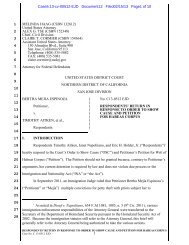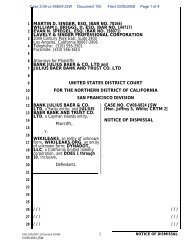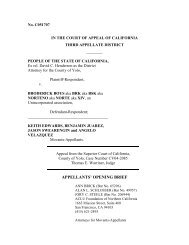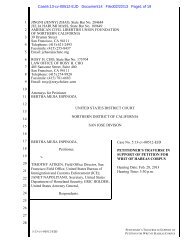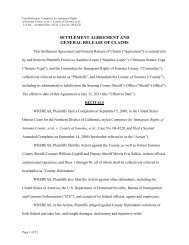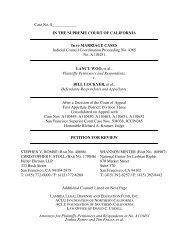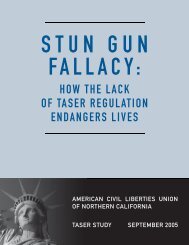ENDNOTES1See Adam Liptak, Inmate Count in U.S. Dwarfs Other Nations’, New York Times, April 23, 2008, available athttp://www.nytimes.com/2008/04/23/us/23prison.html?pagewanted=all.2 In 2008, the Pew Center on the States reported that <strong>California</strong>’s overall prison population was second only to that<strong>of</strong> Texas, and that, “[r]emarkably, 13 states now devote more than $1 billion a year in general funds to theircorrections systems. The undisputed leader is <strong>California</strong>, where spending totaled $8.8 billion last year. Even whenadjusted for inflation, that represents a 216 percent increase over the amount <strong>California</strong> spent on corrections 20years earlier.” Pew Center on the States, One in 100:Behind Bars in America 2008, available athttp://www.pewcenteronthestates.org/uploadedFiles/One%20in%20100.pdf . As <strong>of</strong> December 31, 2010, <strong>California</strong>ranked second in the country in terms <strong>of</strong> overall prison population, and corrections spending has since reached $10billion. See Bureau <strong>of</strong> Justice Statistics, Bulletin: Prisoners in 2010 (Dec. 2011), Appendix Table 1, Prisoners underthe jurisdiction <strong>of</strong> state and federal correctional authorities, by jurisdiction, p. 14, available athttp://bjs.gov/content/pub/pdf/p10.pdf; <strong>California</strong> Department <strong>of</strong> Corrections and Rehabilitation, CDCR AnnualReport (Fall 2011), CDCR Budget Breakdown 2011-12 Budget and Non-Budget Act, p. 11, available athttp://www.cdcr.ca.gov/News/docs/2011_Annual_Report_FINAL.pdf .3 See <strong>California</strong> Department <strong>of</strong> Corrections And Rehabilitation, 2010 Adult Institutions Outcome Evaluation Report,p. 11, available athttp://www.cdcr.ca.gov/Adult_Research_Branch/Research_Documents/ARB_FY0506_Outcome_Evaluation_Report.pdf. See also table comparing state recidivism rates in: The Pew Center on the States, State <strong>of</strong> Recidivism April2011: The Revolving Door <strong>of</strong> America’s Prisons, pp. 10-11 , available athttp://www.pewcenteronthestates.org/uploadedFiles/Pew_State_<strong>of</strong>_Recidivism.pdf.4 See, e.g., Michael A. Fletcher, Governors Plan Painful Cuts Amid Budget Crises Across the U.S. (Feb. 8, 2011),Washington Post, available at http://www.thefiscaltimes.com/Articles/2011/02/08/WP-Governors-Plan-Painful-Cuts.aspx#page1 (“Faced with the most severe budget crisis since the Great Depression, governors across theideological spectrum are embracing the politics <strong>of</strong> austerity in a desperate effort to balance the books.”)5African-Americans are incarcerated at a rate <strong>of</strong> approximately 2,121 per 100,000 in <strong>California</strong> prisons; thesefigures do not include those incarcerated in county jails or federal prisons located in <strong>California</strong>. <strong>California</strong>Department Of Corrections and Rehabilitation, Offender Information Services Branch Estimates and StatisticalAnalysis Section, Data Analysis Unit, <strong>California</strong> Prisoners and Parolees, p. 19 (2009) [hereinafter CDCR Estimatesand Statistical Analysis], available athttp://www.cdcr.ca.gov/Reports_Research/Offender_Information_Services_Branch/Annual/CalPris/CALPRISd2009.pdf (last visited August 8, 2011) (48,990 blacks were incarcerated in CDCR intuitions at year-end 2009); U.S.Census Bureau, CenStats Databases, USA Counties, General Pr<strong>of</strong>ile <strong>California</strong> (2010) , available athttp://censtats.census.gov/usa/usa.shtml (last visited August 8, 2011) (there were approximately 2,309,745 African-Americans in <strong>California</strong> in 2010). Under apartheid South Africa blacks were incarcerated at a rate <strong>of</strong> approximately851 per 100,000. Prison Policy Initiative, Section IV: Global Comparisons, Crime and incarceration around theworld: U.S. vs. South Africa, available at http://www.prisonpolicy.org/prisonindex/us_southafrica.html (last visitedAugust 8, 2011); see also Michelle Alexander, The New Jim Crow: Mass Incarceration in the Age <strong>of</strong> Colorblindnesspp. 6-7 (2010).6 See CDCR, supra note 5 (Hispanics make up 39.3% <strong>of</strong> the CDCR institution population, while whites, blacks andothers represent 25.6%, 29.0%, and 6.1% respectively).7 See, e.g., Roger Warren, Viewpoints: <strong>Realignment</strong> can boost public safety (Nov. 13, 2011), available athttp://www.courts.ca.gov/partners/documents/realignmentpublicsafety.pdf. The author is a retired 20-year veteran<strong>of</strong> Sacramento County trial court and is President Emeritus <strong>of</strong> the National Center for State Courts.8 Cal. Penal Code § 17.5(a).44
9 See., e.g. Marissa Lagos, SG Gate, September 21, 2011, Gov. Jerry Brown promises constitutional amendment t<strong>of</strong>und realignment, available at http://blog.sfgate.com/nov05election/2011/09/21/gov-jerry-brown-promisesconstitutional-amendment-to-fund-realignment/,“The governor and other supporters believe that city police andcounty sheriffs, probation departments and social service programs will do a better job helping low-level <strong>of</strong>fendersstay out <strong>of</strong> trouble.” See also comments from local government <strong>of</strong>ficials from around the state concurring that localgovernments can do a better job than the state, e.g., at, “Keeping individuals closer to the community, keeping themcloser to their families, and connecting them with community-based resources that they're going to need to besuccessful when they get out, because they are going to get out.”10 Cal. Penal Code § 17.5. The legislative findings underlying the realignment legislation include the following:“Despite the dramatic increase in corrections spending over the past two decades, national reincarceration rates forpeople released from prison remain unchanged or have worsened. National data show that about 40 percent <strong>of</strong>released individuals are reincarcerated within three years. In <strong>California</strong>, the recidivism rate for persons who haveserved time in prison is even greater than the national average.”11 Brown v. Plata, 131 S.Ct. 1910 (2011).12 <strong>California</strong> state prisons were designed to hold 79,858 prisoners. However, they housed approximately 143,000prisoners at the time <strong>of</strong> the Plata decision, which ordered <strong>California</strong> to reduce its prison population byapproximately 33,000 prisoners to 137.5% <strong>of</strong> design capacity, or approximately 109,800 prisoners. <strong>California</strong>Department <strong>of</strong> Corrections and Rehabilitation, State Responds to Three-Judge Court’s Order Requiring a Reductionin Prison Crowding (Jun. 7, 2011), CDCR Today, available at http://cdcrtoday.blogspot.com/2011/06/stateresponds-to-three-judge-courts.html;Plata, 131 S.Ct. at 1943-47.13 Defendant’s January 2012 Status Report in Response to June 30, 2011 Order (Jan 6. 2012), p. 3, available athttp://www.cdcr.ca.gov/News/docs/Jan-2012-Pop-Status-Update.pdf. Updated figures are available athttp://www.cdcr.ca.gov/News/3_judge_panel_decision.html.14 <strong>ACLU</strong> <strong>of</strong> <strong>California</strong>, Community <strong>Safety</strong>, Community Solutions: Implementing AB 109: Enhancing <strong>Public</strong> <strong>Safety</strong>,Saving Money and Wisely Allocating Limited Jail Space (Aug. 2011), available athttp://www.aclunc.org/issues/criminal_justice/asset_upload_file85_10684.pdf.15 See, e.g., the legislative findings codified at Cal. Penal Code § 17.5, which include the following: “<strong>California</strong> mustreinvest its criminal justice resources to support community-based corrections programs and evidence-basedpractices . . . . Realigning low-level felony <strong>of</strong>fenders who do not have prior convictions for serious, violent, or sex<strong>of</strong>fenses to locally run community-based corrections programs, which are strengthened through community-basedpunishment, evidence-based practices, improved supervision strategies, and enhanced secured capacity, willimprove public safety outcomes among adult felons and facilitate their reintegration back into society. Communitybasedcorrections programs require a partnership between local public safety entities and the county to provide andexpand the use <strong>of</strong> community-based punishment for low-level <strong>of</strong>fender populations. Each county's LocalCommunity Corrections Partnership . . . should play a critical role in developing programs and ensuring appropriateoutcomes for low-level <strong>of</strong>fenders.” Section 17.5 defines “community-based punishment” as “correctional sanctionsand programming encompassing a range <strong>of</strong> custodial and noncustodial responses to criminal or noncompliant<strong>of</strong>fender activity.” Examples <strong>of</strong> community-based punishment include: intensive community supervision; homedetention with non-GPS electronic monitoring (such a telephone check-ins) or GPS monitoring; mandatorycommunity service; restorative justice programs such as mandatory victim restitution and victim-<strong>of</strong>fenderreconciliation; work, training, or education in a furlough program, or work, in lieu <strong>of</strong> confinement, in a work releaseprogram; day reporting; residential or nonresidential substance abuse treatment programs; mother-infant careprograms; and community-based residential programs <strong>of</strong>fering structure, supervision, drug treatment, alcoholtreatment, literacy programming, employment counseling, psychological counseling, mental health treatment, or anycombination <strong>of</strong> these and other interventions.45
- Page 1 and 2: PUBLIC SAFETYREALIGNMENTCaliforniaa
- Page 3 and 4: CONTENTS1 Executive Summary3 Introd
- Page 5 and 6: EXECUTIVE SUMMARYCalifornia is at a
- Page 7 and 8: INTRODUCTIONOur criminal justice sy
- Page 9 and 10: MethodologyFor this new report, the
- Page 11 and 12: a transfer of incarceration respons
- Page 13 and 14: adult felons and facilitate their r
- Page 15 and 16: 805,000, received about $5.2 millio
- Page 17 and 18: standardized data on public safety
- Page 19 and 20: educational opportunities when they
- Page 21 and 22: By November 2009, eleven counties h
- Page 23 and 24: population. 63 The percentages of n
- Page 25 and 26: Under the money-based bail system,
- Page 27 and 28: The money-based bail system, with b
- Page 29 and 30: ecause pursuant to AB 109, individu
- Page 31 and 32: standard for pretrial programming
- Page 33 and 34: Counties can free up jail beds by t
- Page 35 and 36: esidential or nonresidential substa
- Page 37 and 38: • The instrument should equitably
- Page 39 and 40: individuals arrested for drug posse
- Page 41 and 42: Flash IncarcerationAlthough graduat
- Page 43 and 44: create new “Alternative Sentencin
- Page 45: RECOMMENDATIONSIt’s time to fix C
- Page 50 and 51: 16 Information about the ballot int
- Page 52 and 53: http://www.lao.ca.gov/ballot/2009/0
- Page 54 and 55: 62 The Bureau of Justice Statistics
- Page 56 and 57: 94 Id.95 The District of Columbia J
- Page 58 and 59: 125 See Butte County Public Safety
- Page 60 and 61: APPENDIX AProfiles of the “Big 25
- Page 62 and 63: State Prison “High Use” Countie
- Page 64 and 65: • Contra Costa County: The County
- Page 66 and 67: categorized amounts shown in the pr
- Page 68 and 69: Contra CostaCounty Population/ranki
- Page 71 and 72: KingsCounty Population/ranking: #32
- Page 73 and 74: MontereyCounty Population/ranking:
- Page 75 and 76: PlacerCounty Population/ranking: #2
- Page 77 and 78: SacramentoCounty Population/ranking
- Page 79 and 80: San DiegoCounty Population/ranking:
- Page 81 and 82: San JoaquinCounty Population/rankin
- Page 83 and 84: Santa BarbaraCounty Population: #18
- Page 85 and 86: ShastaCounty Population: #30 (107,6
- Page 87 and 88: SonomaCounty Population: #17 (310,0
- Page 89 and 90: TulareCounty Population: #21 (256,2
- Page 91 and 92: YoloCounty Population: #28 (135,447
- Page 93 and 94: Mental Health Department for a Mult
- Page 95 and 96: Best of the Best:Model Evidence-bas
- Page 97 and 98: Trinity County’s realignment plan
- Page 99 and 100:
Attorney may work together to devel
- Page 101 and 102:
alternative sentencing strategies f
- Page 103 and 104:
APPENDIX CEducation and Job Trainin
- Page 105 and 106:
Programs: What Works and What Does
- Page 107 and 108:
APPENDIX DDrug Courts: Alternatives
- Page 109 and 110:
o including alcohol and drug treatm
- Page 112:
ACLU of Northern California39 Drumm



